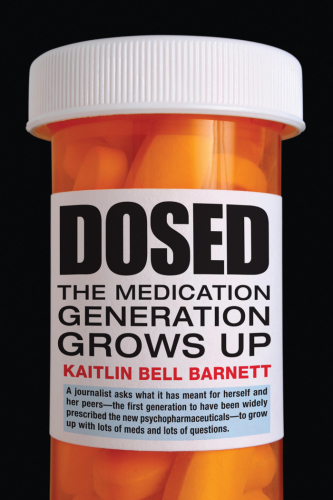
Dosed
The Medication Generation Grows Up
نسل داروها بالا میرود
کتاب های مرتبط
- اطلاعات
- نقد و بررسی
- دیدگاه کاربران
نقد و بررسی

February 20, 2012
Call them Generation M—for medicated. In this sometimes disturbing and often heartbreaking debut, journalist and blogger (PsychCentral.com) Barnett chronicles her own rocky road to adulthood and that of five of her peers—all medicated since childhood for diagnoses ranging from attention deficit disorder to depression. Rather than enter debates about medicated children, Barnett focuses on the experiences of the young people themselves, their rebellions, breakdowns, and battle with side effects. By 1996, nearly a million American children were taking psychotropic drugs—triple the number nine years earlier. Nonjudgmental and well-versed in the medical literature, Barnett laces her profiles with the history of our understanding of childhood mental illness and its treatment. Among those profiled is Claire, who at age 11, worried about the pointlessness of life, became emotionally volatile; she willingly started taking an antidepressant; 20 years later she still accepts her need for medication. On the other hand, Paul, who acted out aggressively while spending his youth unhappily in foster homes, was put on Ritalin at age five, and as an adult he saw his medication as the wrong treatment for behavior stemming from a troubled childhood. Cogent and thoughtful, Barnett argues that we need a great deal more research on the long-term impact of psychotropic medications on children’s mental and physical health, but also on their self-perception.

February 15, 2012
A freelance journalist delves into what has been called a giant uncontrolled experiment using America's children as guinea pigs. As a member of this group herself, Barnett explores the issues faced by the first generation of children, now entering adulthood, who were treated with psychopharmaceutical drugs from the time they were youngsters. For the past two decades, American children have been increasingly prescribed psychiatric medications for a rainbow of conditions including depression, attention deficit disorder, bipolar disorder, obsessive-compulsive disorder and more general behavioral problems. The author notes most of the drugs "were and still are prescribed to children and teens without official FDA approval for the relevant condition and age group." Childcare books during this period categorized kids with these issues as difficult or problem children, whose behaviors unsettled not just their family but became "a threat to the entire family dynamic that needed to be addressed and dealt with." A new class of drugs developed during the 1990s, the selective serotonin reuptake inhibitors (SSRI) held out the hope of relief, if not a miracle cure. During this period, the FDA allowed pharmaceutical companies direct access to consumers through TV advertising. Barnett tackles this complex saga by chronicling the stories of five individuals who were medicated as youngsters, weaving their narratives together with a learned discussion of psychiatric treatments, medical models, side effects breakdowns, and the numerous issues faced when medicated children attend school. The author began her research after reading an article about a woman in her 30s, who, having been on medication since she was 14, wondered how drugs "had shaped her psychological development and ultimately her identity." The woman's psychiatrist noted that his patient was just one of many who raised this question. Occasionally Barnett, who began taking Prozac when she was 17, adds her point of view to the discussion. The author's clear rending of the tough questions surrounding this knotty topic should make it required reading for anyone touched by this issue.
COPYRIGHT(2012) Kirkus Reviews, ALL RIGHTS RESERVED.

April 15, 2012
In this well-written, thoughtful book, journalist Barnett tells the stories of five young people who took medications to treat psychiatric problems such as depression, anxiety, and attention deficit disorder. Some drugs work better than others. Barnett, a Prozac user herself, tries to paint a balanced picture. She notes that SSRI (selective serotonin reuptake inhibitor)antidepressants can cause troublesome side effects, such as loss of libido and trouble with sexual performance, and bad interactions when taken with alcohol. Those who oppose psychiatric medication will not like Barnett's generally positive take on prescription drugs. She seems to be living happily ever after with her new husband, and Claire, the most prominent real person in the book, also gets married (to someone else with depression) and has a baby. Elizabeth Wurtzel's famous memoir Prozac Nation (1994), which Barnett references, created a media sensation. Barnett's won't. But it does provide quality food for thought for any family trying to decide how to treat a child with a psychiatric disorder so that he or she can grow up being his or her best self.(Reprinted with permission of Booklist, copyright 2012, American Library Association.)

























دیدگاه کاربران